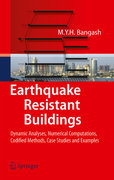
Earthquake resistant buildings: dynamic analyses, numerical computations, codified methods, case studies and examples
Bangash, M.Y.H.
This concise work provides a general introduction to the design of buildings which must be resistant to the effect of earthquakes. A major part of this design involves the building structure which has a primary role in preventing serious damage or structural collapse. Much of the material presented in this book examines building structures. Due to the recent discovery of vertical components, it examines not only the resistance to lateral forces but also analyses the disastrous influence of vertical components. The work is written for Practicing Civil, Structural, and Mechanical Engineers, Seismologists and Geoscientists. It serves as a knowledge source for graduate students and their instructors. This is the first comprehensive introduction to earthquake resistant design and construction of buildings, providing the reader with a plan of the mostimportant topics – starting from the soil analysis to the anchorage of tall buildings Particular attention is paid to vertical movement – the most dangerous and destructive motion Many design examples and case studies are included INDICE: Introduction into Earthquake and General Introduction into Structural Dynamics.- Geotechnics and Earthquakes.- Building Codes.- Design Analysis of Low and Medium Rise Buildings.- Testing.- Seismic Analysis and Design of Tall Buildings and Components.- New Technology: Preveting Damages of Buildings.
- ISBN: 978-3-540-93817-0
- Editorial: Springer
- Encuadernacion: Cartoné
- Páginas: 900
- Fecha Publicación: 15/02/2010
- Nº Volúmenes: 1
- Idioma: Inglés
